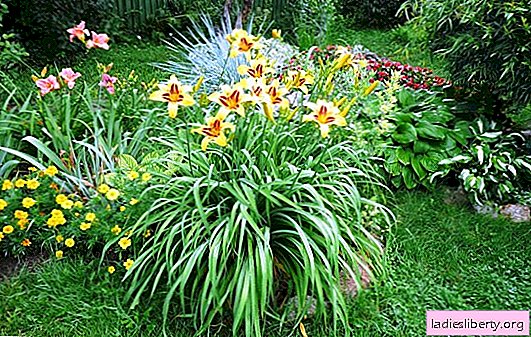
Daylilies belong to unpretentious crops that are able to grow in any conditions.
But the flowers should not survive, but please with their appearance.
To do this, they need special care and simple care.
If the varieties are correctly arranged according to the flowering period, then you can enjoy the beauty of daylilies from spring to autumn, new buds will open throughout the season.
Choosing daylily seedlings: a few simple rules
Many gardeners often confuse lilies with daylilies, because their flowers are incredibly similar, but there are still differences. When buying a seedling, you should pay attention to the following factors:
• Daylily propagates by rhizome, in contrast to lilies, which give a daughter bulb.
• You can buy daylily seedlings in the cold season, they are perfectly stored until spring.
• Storage of seedlings should be carried out at a temperature of from +3 to +5 degrees.
• If buds have hatched on the plot, then after purchase you should plant the plant in a pot.
• The stems of the seedling should be cut at a distance of about 10-15 cm from the root system.

Important! Daylily, which is planted in a pot, in the spring will well transfer the transplant to a permanent place.
Planting daylily in the garden
The best time for planting or transplanting daylily is August, when the plant has bloomed. But you can postpone this procedure until spring, when warm, warm days are established.
Choose a place to land
Daylily grows well in sunny areas, but direct rays are bad for leaves and flowers. More variegated varieties need to be planted in light partial shade, then flowering will be longer, and the leaves will not fade in the sun.
Choosing a place for landing, you need to take care that in the spring there is no stagnation of water. Daylilies do not tolerate prolonged contact with high groundwater.
Land preparation for planting
The plant prefers nutritious soils, if the land on the site is heavy, then it must be prepared. The area for daylilies is dug up, adding leaf humus, compost and sand.
Planting pits should be of a suitable size so that the roots are freely located in them. The distances between daylilies leave so much that the plants develop comfortably for several years. The optimal distance is up to 70 cm.
Basic landing rules
1. A little soil is poured into the prepared hole, making a mound in the center.
2. The rhizome is lowered onto the knoll, spreading the roots on the sides.
3. Sprinkle the seedling with earth carefully, deepening the root neck by only 2-3 cm.
4. The earth around the plant is compacted and well watered so that there are no voids.

If planting was carried out in the autumn period, then often you do not need to water the seedlings, it is enough to monitor the moisture level. With the approaching frost, new landings need to be mulched.
When planting daylilies in spring, you need to water the plants daily for the first week. The soil under the seedlings is mulched to preserve moisture. After a few weeks, daylilies can be fed with complex fertilizers.
Important! Many gardeners complain that daylily does not bloom. The cause of this problem is a too low landing, in which the root collar is deep in the soil.
Outdoor daylily care
Recently, in the garden you can find a variety of varieties of daylilies, which differ from ordinary relatives with a palette of colors and sizes. But such plants require special attention and care.
Watering a plant
Watering daylily should be plentiful, so that moisture well permeates the soil. Frequent surface watering will not benefit the plant. When watering, you need to make sure that the drops do not fall on the delicate petals of the flower. It will be more correct to water the daylily under the root.
On hot summer days, watering should be arranged so that the plants do not suffer from a lack of moisture. Sometimes you need to water the plantings every other day.
Important! Water, which is available in sufficient quantities to plants, contributes to the formation of large buds.
Daylily loves water, but watering should not be frequent, but plentiful. The best time for this is evening. The cool of the night contributes to the good growth of the bush.
How to fertilize a shrub
Daylilies can be grown without the use of fertilizers, but the plant will not refuse to feed. It will quickly respond by active growth and prolonged lush flowering.
Phosphate-potassium fertilizers are used for feeding daylilies, which contribute to a good growth of the root system, increase the plant's resistance to diseases, provide foliage nutrition and allow full bloom. The introduction of complex mineral fertilizers is combined with loosening the soil.
1. The first top dressing is carried out in the spring, dry granules of mineral fertilizers are laid out under a bush, trying not to get on the leaves.
2. With the onset of active growth, the amount of nitrogen in nutrient mixtures is increased. For this purpose, saltpeter or urea is used.
3. During the budding period, daylily is useful to feed with organic fertilizers: infusion of fermented grass, mullein.
4. The last top dressing is carried out one month after the end of flowering, in order to prepare the plant for the next season. During this period, superphosphate and ash are used.
Advice! After applying any fertilizer, the plants are watered abundantly.
We prepare daylily for winter
When caring for daylily in the open ground, you must take care of the wintering of the plant. To do this, carry out a number of simple procedures.
Daylily pruning
A herbaceous plant needs pruning, which is carried out as follows:
• Peduncles pruned as soon as flowering has ended so that the plant does not expend power.
• If the weather is wet, then the flowers themselves will not fall, in which case you need to cut them yourself.
• In August - September, the plant is prepared for wintering, cutting off the aerial part, leaving only young shoots. If this is not done, then with the onset of rains daylilies are attacked by various diseases.
Mulching landings
The winter type of mulch is used to maintain heat in order to provide a comfortable temperature to the root system of the plant. Mulching is carried out when cold weather has already set in, but the ground has not yet frozen. As a shelter, straw, chopped needles or foliage is used.
Young seedlings who have not yet had time to get stronger by winter need shelter. In early spring, all layers of mulching material are removed when the ground is fully warmed up.
When to transplant daylily
Daylilies are not transplanted without need. In one place, the plant develops beautifully and blooms for about 5 - 7 years. When there is a decline in flowering, and the bushes are too large, you can think about transplanting.
It is better to transplant a daylily in September, for this an old bush is dug up and divided into plots. Young plants are planted in a new place.
Transplantation may be required earlier if all conditions for daylily cultivation have not been met or rules for caring for daylily in open ground have been violated.
Diseases and Pests
As a rule, daylily is resistant to diseases and is rarely affected by pests. The main problem when growing is the lack of flowering. For this, the plant needs to be dug and transplanted according to all the rules.











